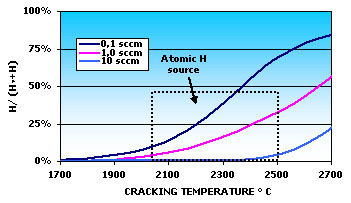Hydrogen Source:
Please contact us to find the best suitable
model for your needs: webrequest@episerve.de
This source generates a flux of atomic hydrogen through
high tempera-ture thermal cracking of molecular hydrogen
(or deuterium) with a tungsten filament. A flux of atomic hydrogen has been
shown to convert carbon and oxygen based contaminants on substrate surfaces
into volatile species which evaporate readily at relatively low temperatures.
Hence an atomic hydrogen source is very useful for in-situ low temperature
cleaning of substrates. It has also been suggested that growth rate in Ga-rich
deposition of GaN is considerably enhanced under a flux of atomic hydrogen.
An atomic hydrogen source represents an ideal solution for in-situ low temperature
surface preparation, substrate cleaning and selective MBE. All models are
equipped with water cooling system to regulate the flange temperature.
Applications Atomic
flow data
* GaAs, InP, CdTe substrate cleaning
* Promotes 2D epitaxial growth on GaAs by surfactant effect.
* Improves lattice matching in InAs/InP
* Si substrate preparation for GaAs growth
* Generation of atomically flat surface of SiC
* As and P etching
* Selective epitaxial growth in patterned GaAs MBE
Atomic flow data:
| H2 Flux SCCM | P system (400 l/s) | H/(H2+H) (2200°C) | Calculated H Flux At/s |
| 1 | 4 10-6 mbar | 8% | 8,64 10+16 |
| 0,5 | 2 10-6 mbar | 20% | 1,08 10+17 |
| 0,2 | 8 10-6 mbar | 40% | 3,60 10+16 |
| 0,05 | 2 10-6 mbar | 60% | 1,35 10+16 |
Dissociation efficiency

The curves show the dissociation efficiency of
molecular hydrogen cracked on an heated tungsten surface.
The efficiency is strongly dependent of the H2 pressure, that is the flow
of molecules for a given source conductance, the flows used here will give
system vacuum pressures of 10-6 to 10-5 mbar with the usual pumping speed
of standard MBE systems ( pumping speed of several 100 l/min). The best
working conditions should take the cracking efficiency / flow rate dependance
in consideration.
The following table shows some atomic H flow data at usual working conditions.
Specifications
Gas: H2 only (For other gases see Gas sources documentation)
Cracking efficiency: up to 40%
Operating cracking temperature: from 2000 to 2800 °K
Gas connection: VCR (0.1 to 1 cc/minute are usual flow rates)
CBr4 (option): VCR female
Thermocouples (option): Type C (W Re 5/26)
Minimum mounting flange: 35CF / 70mm / 2.75"
Power supply: DC - See attached
In-vacuum diameter: according to system
Power supply connectors System or ADDON via universal UNIPLUG
Options On request, the source can be equipped with a thermocouple which
allows regulation of the temperature in the cracking zone.
The thermocouple does not give a readout of the absolute temperature of
the filament because it is too high.
It can, however, be used for calibration Also as an option the source can
be furnished with a second gas entry for use with gases which do not need
to be cracked. In this case the W filament can be supplied with 4 Amps so
as to avoid condensation in the supply tubes for this gas.
If this source is used in a system without cryopanels (LN2 or water) it
is a good idea to install a water cooled panel around the cracking zone.
The minimum flange size for this option is DN60CF.
copyright EpiServe GmbH 2017, all rights reserved